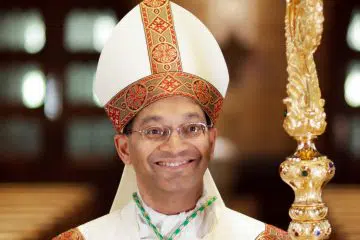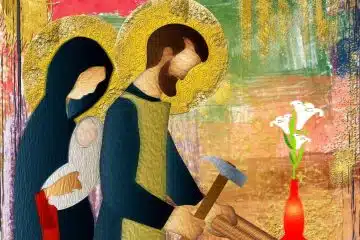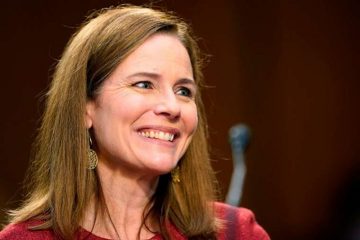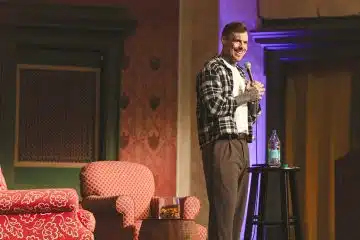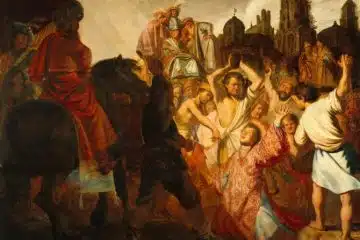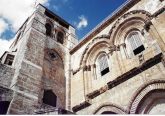Educating the educators
Wednesday, August 18, 2010
Archdiocesan group learns firsthand lessons about the Holy Land
By Eileen Connelly, OSU
ARCHDIOCESE — A group of teachers and administrators from Catholic schools and parishes in the Archdiocese of Cincinnati have been urged to share stories of their Palestinian counterparts following a July trip to the Holy Land.
The trip was an educational initiative sponsored by the Holy Land Christian Ecumenical Foundation (HCEF) and the archdiocesan Catholic Schools and Mission offices. Nancy Hemminger, a long-time HCEF volunteer and member of St. Andrew Parish in Milford, served as coordinator for the trip, which offered both a spiritual experience to participants as well as experience with Project HOPE, HCEF’s outreach program to Palestinian educators.
 |
| Nancy Hemminger touches the star on the site of Bethlehem’s Church of the Nativity, where according to tradition, Mary gave birth to Jesus. (CT/Mark Bowen) |
Archdiocesan educators were invited on the trip to support their counterparts in the Holy Land after Hemminger gave a presentation at a principals’ meeting last year. To prepare for the educational outreach portion of their trip, the local educators attended in-service programs that gave them a broader perspective on the civil and religious influences in Palestine.
The July 5-16 trip began in Amman, Jordan, with a visit to the baptismal site of Jesus and Mount Nebo. In Jerusalem the group spent time in the Old City, at the Western Wall, the Temple Mount, the Mount of Olives and Garden of Gethsemane. There was also time for private prayer and Mass at the Shrine of the Holy Sepulchre, followed by an audience with Latin Patriarch of Jerusalem Archbishop Fouad Twal.
The itinerary included Galilee and Bethlehem, where a highlight of the trip was the celebration of “A Day of Solidarity” on July 10. The event partnered 13 archdiocesan educators with 13 Palestinian teachers and administrators in small groups based on grade level taught.
“The day was filled with animated discussions, laughing and sharing,” Hemminger said. “Jesus, our best teacher, spoke in parables that taught us how to live, and the [Latin Patriarch] teachers shared stories that taught our archdiocesan teachers the same lessons as the parables…forgiveness, courage, compassion for others.”
“The teachers just wanted to share their stories,” said Sean Ater, pastoral associate for evangelization and catechesis at Immaculate Heart of Mary Parish, who took part in the pilgrimage in his role as an administrator and because of his expertise in instructional technology. “They talked about the frustrations of teaching children who feel like they don’t have any opportunity and no future. They’re passionate teachers who love what they’re doing and love the kids, but they’re frustrated because of the hopelessness of the younger generation and that education doesn’t seem to matter to them. All I could do was say, ‘I hear you and will tell other people about this.’”
Kerry Sullivan, who teaches eighth-grade religion and English at John XXIII Catholic Elementary School in Middletown, was partnered with a Palestinian educator who teaches freshman and sophomore English.
“We talked about what it’s like to teach there, their teaching practices and how their schools are set up very different than ours,” Sullivan said. “Their teachers move from classroom to classroom and the students stay in the same place. She felt that their curriculum doesn’t expect enough of the students, is too limiting and doesn’t give the teachers enough resources to draw from. They have to teach very slowly because the resources don’t last all year and students get restless.”
“We found out how much we have in common,” said Aimee Ellmaker, principal at Our Lady of Lourdes School. “As educators, we’re all trying to do the same thing — educate our students in a Christian environment. The differences would be in terms of day-to-day life — the small classrooms, the hurdles they have to overcome, the fact that they’re strapped for resources. They should be proud of what they’re able to accomplish, like the number of languages students are required to know. First it’s Arabic, then English, Italian and French.”
 |
| Karen Matuszek, special education coordinator at Archbishop Moeller High School, visits with an elderly woman at the HCEF Birzeit Father Anton Buzo Senior Citizen Center. (CT/Mark Bowen) |
In her group, which included Latin Patriarch primary grade educators, Sue Schweickart, who teaches third grade at St. Andrew-St. Elizabeth Ann Seton Consolidated School, was particularly moved by a teacher named Imman.
“She shared her love for teaching and how she considers it her mission not just to teach her students the academics, but how to live,” Schweickart said. “We really connected on that level, because that’s why I teach in a Catholic school.
“I found it interesting that their teacher training is so different from ours,” she added. “They don’t get the child development or classroom management aspects, just the subject matter. Within our group, we shared a lot of classroom management techniques with them.”
That day closed when a special cross with the words HOPE/Archdiocese of Cincinnati in calligraphy was hung in the Bethlehem resource center. Engraved on the outside of the cross are the names of all the HOPE donors and archdiocesan schools that have contributed to the program.
The archdiocesan visitors had the opportunity to connect with the Palestinian people on the trip.
JoAnne Lacey, a member of St. Andrew Parish and a former teacher at St. Gertrude School in Madeira, said, “It’s difficult to see the checkpoints they have to go through, the bars on the windows of their houses because they live in fear, the fact that there are no swing sets, basketball hoops or parks on their side of the wall. There’s nothing that can prepare you for the sight of the wall,” she said, referring to the Israeli-built wall that separates Jerusalem from Bethlehem and restricts the movement of residents of the West Bank and the Palestinian territories.
“When they tell their stories, they don’t do it with any anger toward the Israelites,” she said. “It’s just ‘This is our story, this is how life is for us.’ I just held their hands, looked into their eyes and told them, ‘I will be your voice.’”
“We talked a lot about the wall and how it feels to live with it,” said Jan Reed, lay ecclesial minister for evangelization and catechesis at Our Lady of Mercy Parish in Dayton. “It diminishes hope among the children, and is a constant reminder that they’re not welcome in their homeland.”
Under the umbrella of HCEF’s Ecumenical Center for Research and Development (ECRD) in Bethlehem, Project HOPE’s purpose, explained Hemminger, is to assure Palestinians that there are American Christians who are concerned about their wellbeing and the education of their children.
Project HOPE has its origins in a 2003 HCEF initiative between Annunciation Parish in Beit Jala and Milford’s St. Andrew Parish. The Children’s Peace Program consisted of five Palestinian eighth graders and their teachers visiting the local school and parish. The program soon spread to other schools locally, including Assumption, All Saints and St. Susanna, and moved beyond to take on a national status.
Program leaders were surprised and unprepared, Hemminger said, when two children visiting from the Holy Land in 2007 exhibited serious stress and aggression issues.
The next year, Rateb Rabie, president and CEO of HCEF, arranged for her to meet with teachers and administrators from the West Bank. A survey of the group showed 100 percent concern for the post-traumatic stress disorder demonstrated by students due to the constant cycle of violence and crisis in the Palestinian territories.
Palestinian teachers needed three things, Hemminger said: in-service programs taught by experts that would help them identify and meet the needs of children; support from other teachers; and resources such as books and appropriate learning materials.
The result was a network that included assistance from the University of Cincinnati, Scholastic Books and private individuals who agreed to support HOPE.
UC instructors Steve Kroeger and Stephanie Amsbary volunteered their time to provide a four-day in-service from June 28 to July 1 for 28 Latin Patriarch teachers and administrators. Students from archdiocesan schools donated the funds to provide the technology for the in-service, and the UC instructors will continue to communicate with the Palestinian educators via computer technology.
A HOPE Resource Center was created, which contains materials “purchased” by many St. Andrew volunteers who worked at Scholastic Warehouse for vouchers that were exchanged for new books. The books were processed, packed into donated backpacks and delivered to the center by pilgrims from parishes in the archdiocese, Detroit and Washington, D.C.
The local teachers wrote cross-curricular lessons plans connecting the theme of peace and justice in the Holy Land to their archdiocesan graded course of study. These lessons plans will eventually be shared with other teachers in the Archdiocese of Cincinnati.
The group returned home determined to continue the relationships formed and to share the stories they heard. A steering committee has been established to determine next steps, and the local teachers and administrators are staying in contact with the Palestinian educators via email and finding ways to share their experiences with their respective schools and parishes.
Sullivan is researching books by Palestinian authors for her literature class. She plans to use visuals from the Holy Land when her eighth graders study church history and will use the personal stories of the how the Palestinian people are trying to build peace in their own land in her discussion with students about the Beatitudes.
Because her third-grade religion curriculum focuses on becoming disciples and respecting one another’s differences, Schweickart is planning to use photos and stories from the Holy Land with her students to illustrate the point that “it doesn’t matter where you live or what you look like, we’re all God’s children. I think the real-life examples will help them understand,” she said.
At Our Lady of Lourdes, Ellmaker plans to share her photos and experiences with the faculty and upper level students to tie history and religious classes together. The school will also continue to support HCEF through a school-wide collection, she said.
Also planned, said Ater is a PowerPoint presentation and panel discussion that the group hopes to take to schools and parishes throughout the archdiocese. The first forum is scheduled for Oct. 25 at IHM.
“It’s important that their stories are told so we can break down the barriers,” he said, noting that his own misgivings fell away when he dined at the home of a young Palestinian man and his family. “We just talked about their daily life, how water is rationed, how many restrictions there are. They don’t want violence. They just want to live in peace.”
For more information about the pilgrims’ experiences, visit http://hopepilgrims.shutterfly.com.
Click here and here to view additional photos from the trip.


